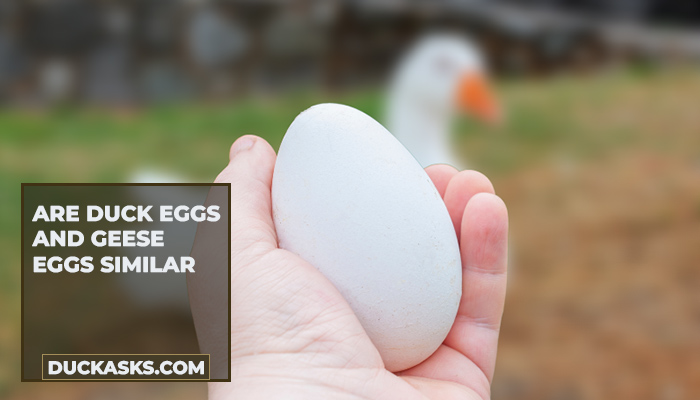Are Ducks Mates for Life?
Ever wonder, are ducks mates for life like most other waterfowls? That’s not really the case. Turns out, they have a completely different mating practice that will absolutely shock you.
Ducks are actually seasonal monogamous in nature. They mate only to reproduce in a particular season and then mate with different partners in the following seasons. However, there are a few exceptions.
Excited to find out more about how long the ducks stay with their mate and whether there are any ducks who mate for life? Here we go!

Looking for more articles about duck breeding:
Do All Duck Species Mate for Life?
Well, most duck species generally don’t mate for life. However, some species, like Whistling Ducks, are exceptions. They are actually the only species of ducks that mate for life.
These Whistling ducks are actually dabblers, that is, they are from the Anatidae family. They live in tropical and subtropical areas of the world.
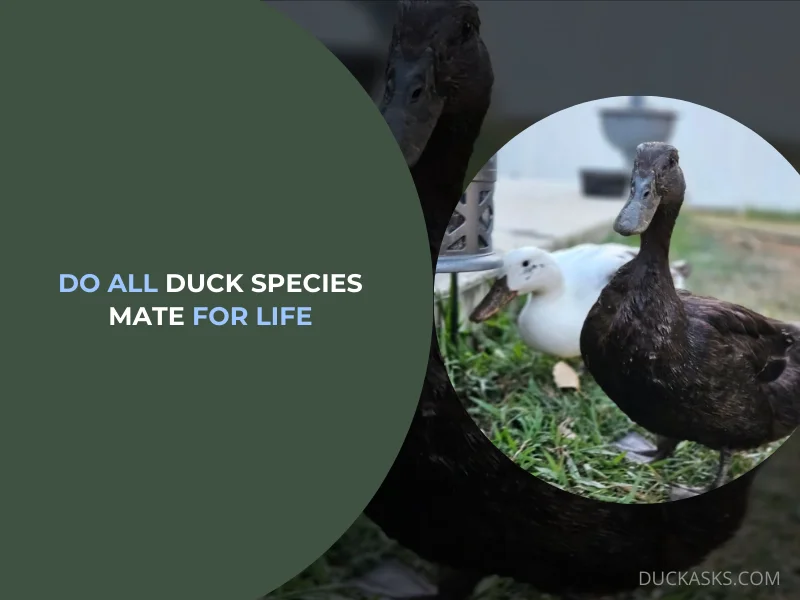
They generally communicate with each other, making distinctive whistling noises. Because of their unique whistling way of communication that they utilize during mating, they are called Whistling ducks.
Dabblers other than Whistling ducks are usually seasonal monogamous in nature. They only stay with their mate for a particular breeding season.
Do Ducks Mate with the Same Duck for Life?
Ducks don’t usually mate with the same duck for life. Even species like Mallards show monogamous behavior for only the breeding season. However, such behavior is a bit complex and varies from duck to duck.
The parental responsibility of ducks is mostly relying on the mother duck. Usually, the father ducks are generally seen to mate with a few female ducks without any commitment or responsibility.
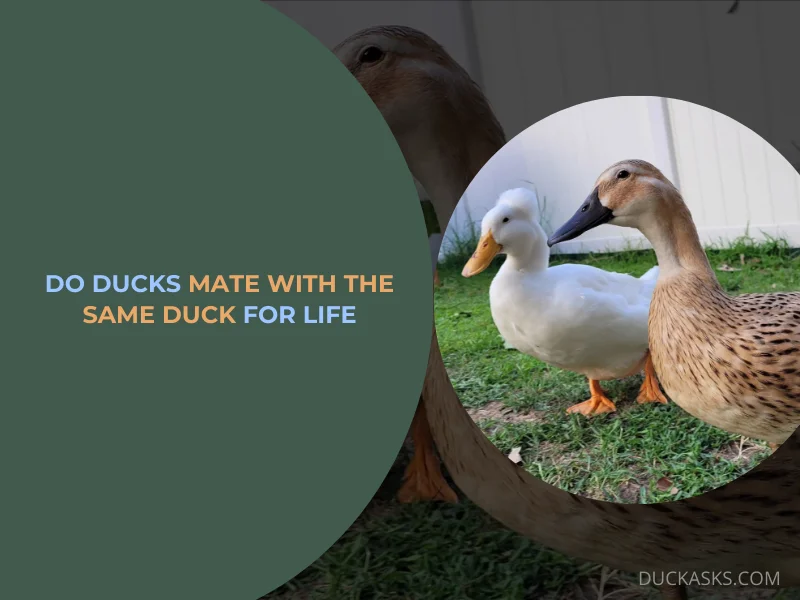
Even in the case of monogamous species like Mallards, the male ducks might have mating behavior with other female ducks while one is conceiving.
So, basically, ducks’ mating policy doesn’t include life-long commitments. They are more of a polygamous and promiscuous creature by nature.
How Long Do Duck Mates Usually Stay Together?
The duration of duck mates staying together varies widely based on the species and circumstances of the ducks.
Usually, ducks might stay together with their mates for just the breeding season, which can be from a few weeks to sometimes, even a few months. For this, they are called seasonal monogamists.
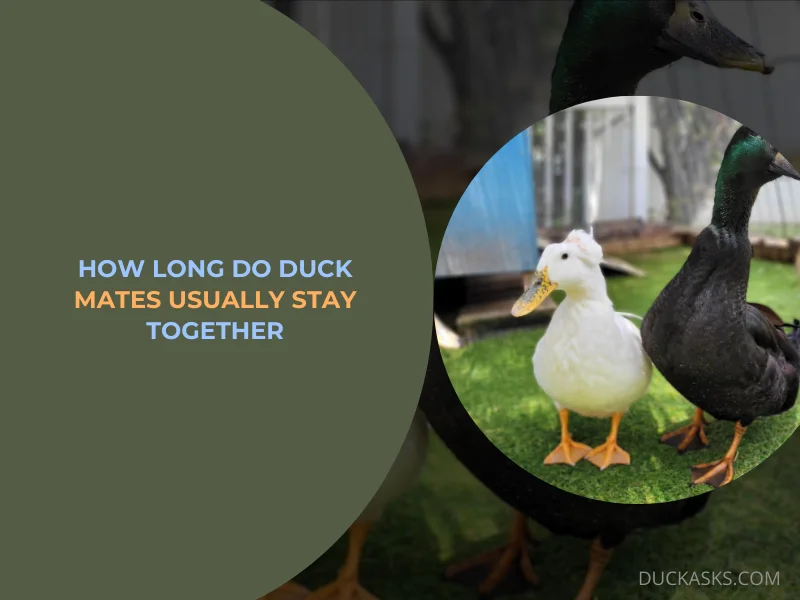
But in most cases, ducks have a very flexible mating system. They might stay together with their mate just for mating. And then switch to another once a female duck conceives.
However, some ducks seem to show re-pairing natures. It means they might mate with the same mate they mated before and had ducklings with in a previous season. This practice is known as philopatry.
How Do Ducks Choose Their Mates and Form Pair Bonds?
How the ducks choose their mates depends mostly on their individual choices, species, and circumstances. Anyway, there is a common pattern and factors that influence these behaviors in most ducks. Here it goes –

01. Courtship Displays
Most duck species exhibit some unique behaviors only to attract their mates in the breeding season. These behaviors are called courtship.
They include visual cues, vocalizations, and body movements that signal the readiness to mate and attract potential partners.
02. Physical Appearance
Like humans and most other creatures of the animal world, ducks also choose their potential mates based on their attractive physical appearance.
Usually, ducks with vibrant plumage, size, or specific features that indicate good health and fitness are commonly attractive to most ducks.
03. Vocalizations
Ducks often use vocalizations as a way to communicate with potential mates. Vocalizations can signal intentions, establish territory, and convey reproductive readiness. That’s how the mates share their desire for mating with each other.
04. Behavioral Compatibility
Every duck has some choices and wishes for its offspring. Even though the male ducks don’t usually participate in the upbringing, they prefer to mate with a female duck who’s good at upbringing, nesting, and fulfilling her responsibilities.
05. Resources and Territory
A duck nests and establishes territory in suitable nesting sites with abundant resources. They prefer to have their mate from the same territory for better compatibility and nesting advantage.
06. Chemical Cues
The uropygial gland of the ducks produces pheromones. They use these pheromones for various activities. This includes mating and recognizing a potential mate within the same species.
What Are the Signs that Ducks Are in a Committed Relationship?
Ducks do not form committed relationships in the same way humans do. Instead, they usually exhibit behaviors and interactions that are geared toward successful reproduction and the raising of offspring.
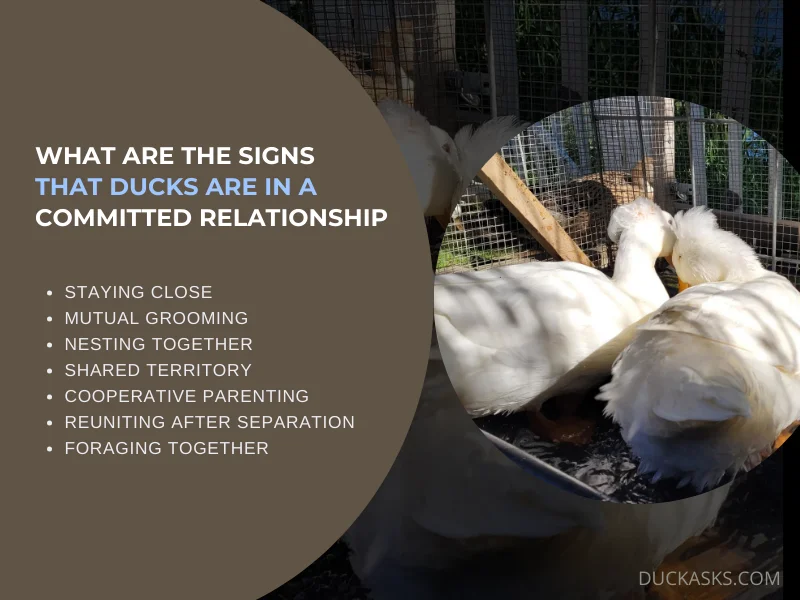
Actually, “commitment” in the human sense doesn’t apply to ducks. However, there are behaviors that indicate pair bonding and cooperation between male and female ducks during the breeding season. Such as –
01. Staying Close
A duck pair often tends to stay close to each other while swimming, foraging, and resting. They follow each other closely and make coordinated movements.
Ducks in a pair exhibit a strong inclination to remain in close proximity during various activities such as swimming, foraging, and resting. This close companionship is marked by synchronized movements and mutual proximity.
02. Mutual Grooming
Paired ducks might sometimes be observed to preen each other’s feathers. This grooming behavior helps strengthen the bond between the pair.
Paired ducks engage in reciprocal feather preening, a behavior that goes beyond maintaining their plumage. This grooming ritual serves to reinforce the emotional connection between the two ducks, enhancing their bond.
03. Nesting Together
Once a pair bond is established, ducks often work together to find a suitable nesting site. So that they can build a nest to incubate eggs and raise the ducklings.
They work in tandem to construct a nest that will serve as an incubation site for their eggs, ensuring the nurturing of their future offspring.
04. Shared Territory
Paired ducks might establish a territory together. Plus, paired ducks establish and jointly protect their designated territory.
This territory serves as their home base, and they cooperate in guarding it against potential threats, including other ducks or intruders who might encroach upon their space.
05. Cooperative Parenting
In a few cases, both the male and female contribute to guarding the nest and caring for the ducklings after they hatch. However, this is an exception for very few species, such as dabblers, divers, and some sea duck species.
06. Reuniting after Separation
If separated for a short time, paired ducks might display excitement and vocalizations upon reuniting.
07. Foraging Together
Paired ducks often forage together. This helps ensure safety and cooperation while feeding the ducklings. However, these behaviors are driven by instincts related to reproduction and the survival of offspring.
Even though they’re indicative of cooperation between male and female ducks, these are not similar to human-like emotional commitment. Ducks form these behaviors just as a part of their natural reproductive strategies.
Conclusion
We hope you aren’t confused anymore about whether are ducks mates for life. Well, they are quite fascinating creatures. The more you know about them, the more it gets interesting.
One thing is clear here: ducks’ mating policy doesn’t have complications like commitments and responsibilities like us humans. So, aren’t you excited to share this with your friends on Facebook, Twitter, and Pinterest? Go ahead!

